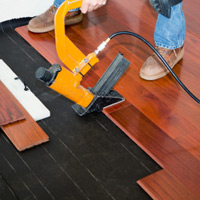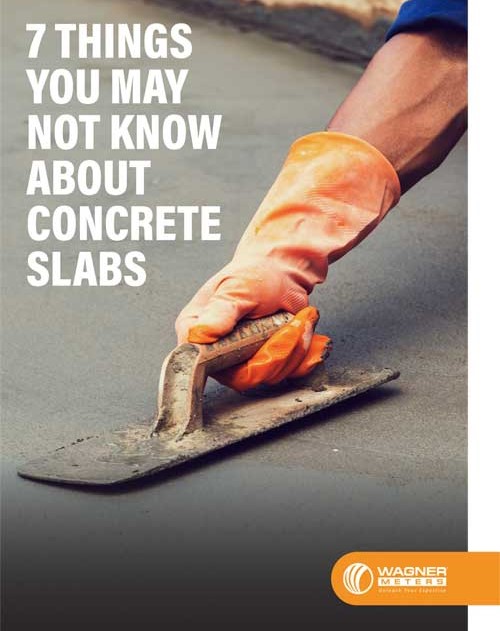Never Assume Concrete Is Dry
The amount of time required for a concrete slab to dry is often reduced to a simple rule of thumb: The ideal drying time is one month for every one inch of slab thickness, once conditions are conducive for drying. However, along with that should be another rule of thumb: Never assume concrete is dry.
What’s on the Line?
Understanding a concrete drying schedule is one thing that has big implications for any project’s schedule and budget. For individual flooring installers, a number of those factors can often be beyond their control. However, it can also be one of the decisions that can have the longest impact on your business and reputation. Assuming concrete is dry is roughly the equivalent of playing Russian roulette with your project schedule, your bottom line, and your reputation.
Let’s take a common scenario:
A six-inch slab has been down for six months (one month per inch, right?) and the schedule says you’re up to begin installing the flooring. The general contractor even went ahead and performed CaCl testing and reports that there is an MVER rate of 3 pounds, sufficient to move ahead according to your flooring manufacturer’s specs.
 You begin installation of a wood floor over the slab, even installing a moisture retarder for good measure. Within 3-6 months you are being called back because the flooring is warping to the point that it is creating trip hazards, or perhaps the finish is blistering, or there is discoloration or mold appearing along the board edges. Whatever the symptom, you arrive on-site where your professional experience tells you that this sure looks like a moisture-related problem.
You begin installation of a wood floor over the slab, even installing a moisture retarder for good measure. Within 3-6 months you are being called back because the flooring is warping to the point that it is creating trip hazards, or perhaps the finish is blistering, or there is discoloration or mold appearing along the board edges. Whatever the symptom, you arrive on-site where your professional experience tells you that this sure looks like a moisture-related problem.
What went wrong? And more importantly, who is responsible to fix it? The general contractor tested for moisture, there are no obvious environmental causes like leaking plumbing or groundwater sources, and the flooring manufacturer is suggesting the warranty is invalid because of installation conditions…how did you get left holding the proverbial bag?
It’s the question behind hundreds of thousands of dollars in moisture-related flooring problems each year, and it’s even more discouraging because it’s entirely preventable.
Understanding Conditions for Drying Concrete
Any rule of thumb is a handy thing, but there are so many additional factors that affect drying time in concrete that this particular rule of thumb can safely be said to be the exception instead of the rule. Extra factors might that will prolong or delay drying time include:
● The ratio of water that was used in the concrete mix
● The thickness of the slab
● Air movement across the slab surface
● Types of aggregate used in the concrete
● The presence of a vapor retarder or vapor barrier under the slab
● The temperature and humidity at the site
● Drainage around the slab
While there are various types of dehumidification equipment that can speed the drying process, none of them are specifically able to guarantee when the concrete slab will have reached the final, equilibrated moisture level necessary for the next step of the building schedule.
Probably the first and most important fact to grasp is that the surface of the slab holds both the key and at the same time, no information at all, for a drying slab. How does that work?
First: The surface is the only escape route for the moisture in a drying concrete slab that is poured on grade (as most floors are). If one surface is exposed, the moisture can only exit the slab from that one surface. As moisture evaporates away from the surface, more moisture can move up to the surface through small capillaries in the drying cycle.
What this leads to is a process that naturally creates a gradient effect for moisture levels in the slab. During the drying process, or until the concrete surface is sealed, moisture levels will be lower near the surface and higher near the bottom of the slab. Once the surface is sealed, the moisture eventually takes on a uniform moisture level through the entire slab, a situation known as equilibration.
Second: The surface of the slab may be the key to allowing the slab to dry but it cannot serve to give an accurate indicator of overall moisture levels. Because moisture levels will be higher lower in the slab, any measurement taken at the surface will not provide a comprehensive moisture picture for the entire slab.
(Without trying to confuse the issue here, it’s also true that an unsealed slab that is suddenly exposed to a change in external conditions (like sudden high humidity or direct water sources) will take in water through the same capillaries that allow moisture to leave the slab. It doesn’t change the fact that any surface-based moisture test will present skewed measurements in any situation.)
So what’s the best option for accurately measuring concrete moisture?

Free Download – 7 Things You May Not Know about Concrete Slabs
Reducing the Risk: RH Testing
 Over the last 30 years, scientific study into concrete moisture testing has proven that relative humidity (RH) testing provides the most accurate and actionable concrete moisture testing available today. RH testing is unique in that it places a sensor or probe IN the concrete slab to provide a balanced moisture measurement. Based on guidelines developed from this testing, for our one-surface slab, that depth has been determined to be 40% of the slab thickness. Measurements taken at this depth provide the best indicator of a final RH level if the slab were to be sealed and allowed to equilibrate at that time. What does this mean for you as the flooring installer?
Over the last 30 years, scientific study into concrete moisture testing has proven that relative humidity (RH) testing provides the most accurate and actionable concrete moisture testing available today. RH testing is unique in that it places a sensor or probe IN the concrete slab to provide a balanced moisture measurement. Based on guidelines developed from this testing, for our one-surface slab, that depth has been determined to be 40% of the slab thickness. Measurements taken at this depth provide the best indicator of a final RH level if the slab were to be sealed and allowed to equilibrate at that time. What does this mean for you as the flooring installer?
With RH testing, you can know with a high degree of accuracy what the final RH level of the slab will be, and therefore what moisture level will be in contact with your applied flooring. It allows informed decisions for changes to materials based on moisture tolerances or allows any necessary remedial steps to be taken before a moisture-related problem rears its ugly head.
The Rapid RH® line of products offers the simplest, fastest, and most affordable means of taking, recording, and reporting moisture measurements on the market. From our Smart Sensors and Total Reader® with Touch-n-Sense™ technology to the award-winning DataMaster™ app, the Rapid RH puts industry innovation and accurate technology in the palm of your hand to increase efficiency, provide accurate ASTM-compliant reporting, and protect your reputation.
Don’t assume you’ve got it covered when it comes to knowing a concrete slab is dry. Be assured with the Rapid RH.
Jason has 20+ years’ experience in sales and sales management in a spectrum of industries and has successfully launched a variety of products to the market, including the original Rapid RH® concrete moisture tests. He currently works with Wagner Meters as our Rapid RH® product sales manager.
Related Posts via Taxonomies
Last updated on October 1st, 2021



